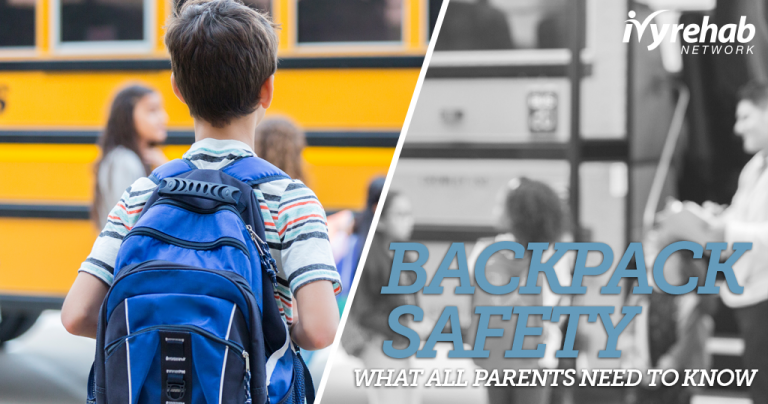
Backpack Safety – What Parents Need To Know
It’s one of the most common back-to-school purchases – a backpack. But when it comes to buying a backpack, parents shouldn’t take a one-size-fits-all approach. We need to keep an eye on what our children are putting into the pack and carrying around on a daily basis. Saddled with homework, heavy books, and technology, today’s grade school children often carry up to 15 pounds! And backpacks injure as many as 14,000 children each year, according to the National Safety Council, which offers a variety of school safety tips.
“Our children literally carry too much weight on their shoulders,” said Becky Turpin, director of home and community safety at the National Safety Council. “Heavy backpacks can create many different problems, from back and shoulder pain to poor posture.”
Buying the Right Backpack
Sure, your child may want to carry around the latest Disney craze or a fancy name brand. Style, price, and features also matter, but fit is the most important factor when buying a backpack.
- Make sure it is the correct size. The pack should not be wider or longer than your child’s torso and never hang lower than 4 inches from the waist.
- Look for hip and chest belts to transfer some of the weight to the hips and torso and keep the pack in place
- Ergonomic design with padded back and wide, padded shoulder straps that adjust
- Multiple compartments to help distribute the weight
- Compression straps on the sides or bottom to stabilize the contents
- Waterproof/weatherproof with reflective material
Correct Wear and Proper Fit
No one likes to be nagged, but it’s important to monitor how your child heads off for the school bus or returns home from school.
- Make sure the weight is evenly distributed across the body, lessening the stress on muscles and joints.
- Is your child using both shoulder straps or wearing it over one shoulder? This can place undue stress on one side of the body, lead to bad posture and back or shoulder pain. Make sure it’s being worn over both shoulders
- Tighten the straps enough for the backpack to fit closely to the body and stay in place.
- The pack should rest evenly in the middle of the back and not sag down to the buttocks. If it hangs too low, it puts more weight on the shoulders.
- Your child may lean forward when walking to compensate for an improper fit or excessively heavy load.
Backpack Safety Throughout the School Year
Folders fill up, snack wrappers accumulate, and supplies such as mini-staplers, tape, and to-go tissue can sneak into compartments. Make sure your child cleans out his or her backpack regularly and removes unnecessary items.
- Regularly check the weight and contents. Put it on a scale if you have to. A backpack should not weigh more than 5 or 10 percent of your child’s body weight, according to the National Safety Council.
- Observe your child’s posture. Do they struggle to pick it up, put it on, hunch forward, carry it on one shoulder, or complain of pain or numbness?
- Bigger is not always better, especially for young children. If there is space to fill, your child is likely to carry more. This becomes even more problematic as the school year goes on.
- Help your child decide what’s essential to carry to and from school. Can heavy books stay at school unless they are needed for homework? Pack pointy or bulky objects in protected compartments and away from the area that rests on your child’s back or could harm them in the event of a fall.
- Check for broken straps and zippers, tears or signs of uneven wear.
Back Pain in Children
Back pain is nothing to ignore. Young children are suffering from back pain much earlier than previous generations, and the use of overweight backpacks is a contributing factor. Good posture also starts at a young age, and carrying too heavy of a load can take a toll on a child’s growing physique.
As a parent, it’s important to take any complaints of pain or discomfort seriously and be proactive to avoid injury or long-term musculoskeletal problems. A lighter backpack is always better and part of backpack safety means knowing how much your child’s pack weighs.
Pain or other physical discomfort means there is a problem! Please get in touch with your local Ivy Rehab Network clinic for a screening or to schedule an appointment with a therapist. We can help assess your child’s complaints, prescribe exercises and offer tips on good posture.
Article by Holly Lookabaugh-Deur, PT, DSc, GCS, CEEAA
Holly Lookabaugh-Deur, PT, DSc, GCS, CEEAA is a practicing physical therapist and a partner and Director of Clinical Services at Ivy Rehab Network. Deur is board certified as a geriatric clinical specialist and certified exercise expert for aging adults with more than 35 years of clinical experience. She is certified as an aquatic and oncology rehabilitation specialist and serves as adjunct faculty at Central Michigan University and Grand Valley State University.
The medical information contained herein is provided as an information resource only, and does not substitute professional medical advice or consultation with healthcare professionals. This information is not intended to be patient education, does not create any patient-provider relationship, and should not be used as a substitute for professional diagnosis, treatment or medical advice. Please consult with your healthcare provider before making any healthcare decisions or for guidance about a specific medical condition. If you think you have a medical emergency, call your doctor or 911 immediately. IvyRehab Network, Inc. disclaims any and all responsibility, and shall have no liability, for any damages, loss, injury or liability whatsoever suffered as a result of your reliance on the information contained herein.